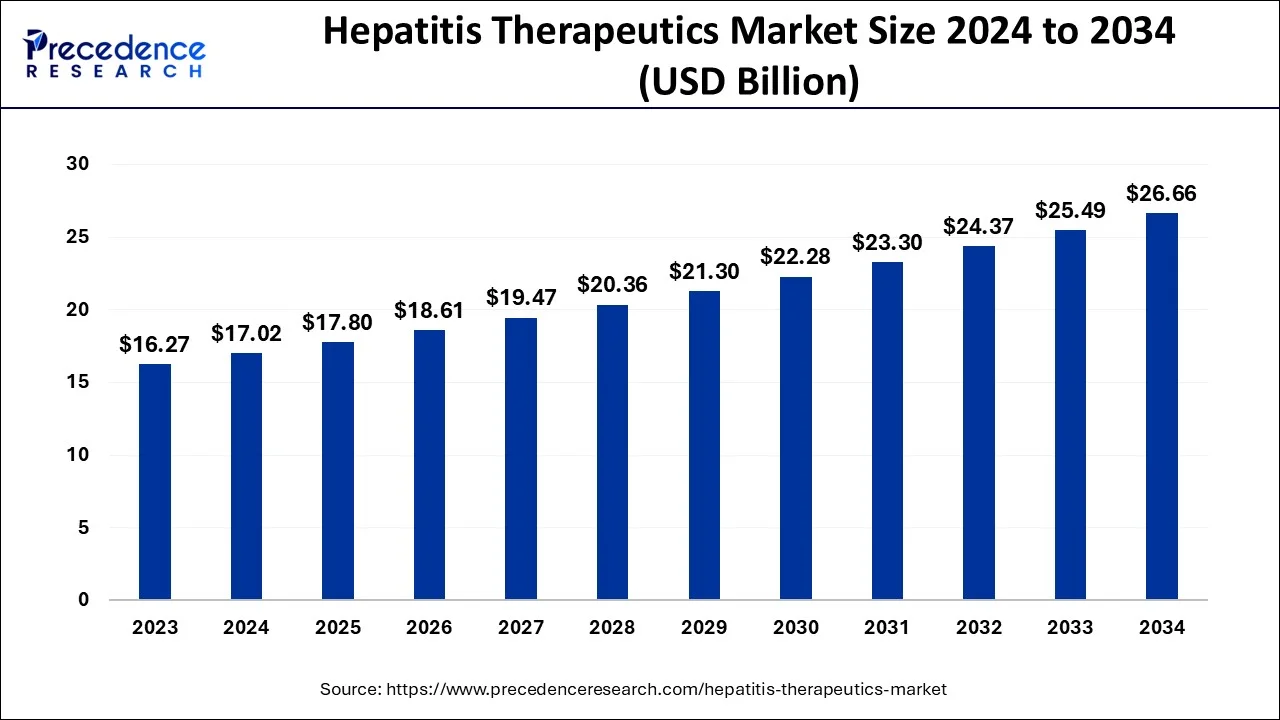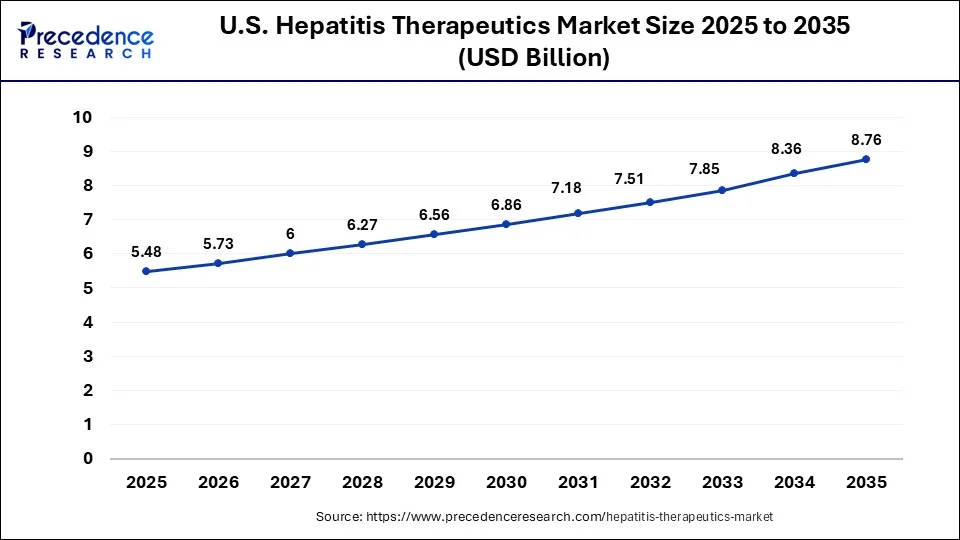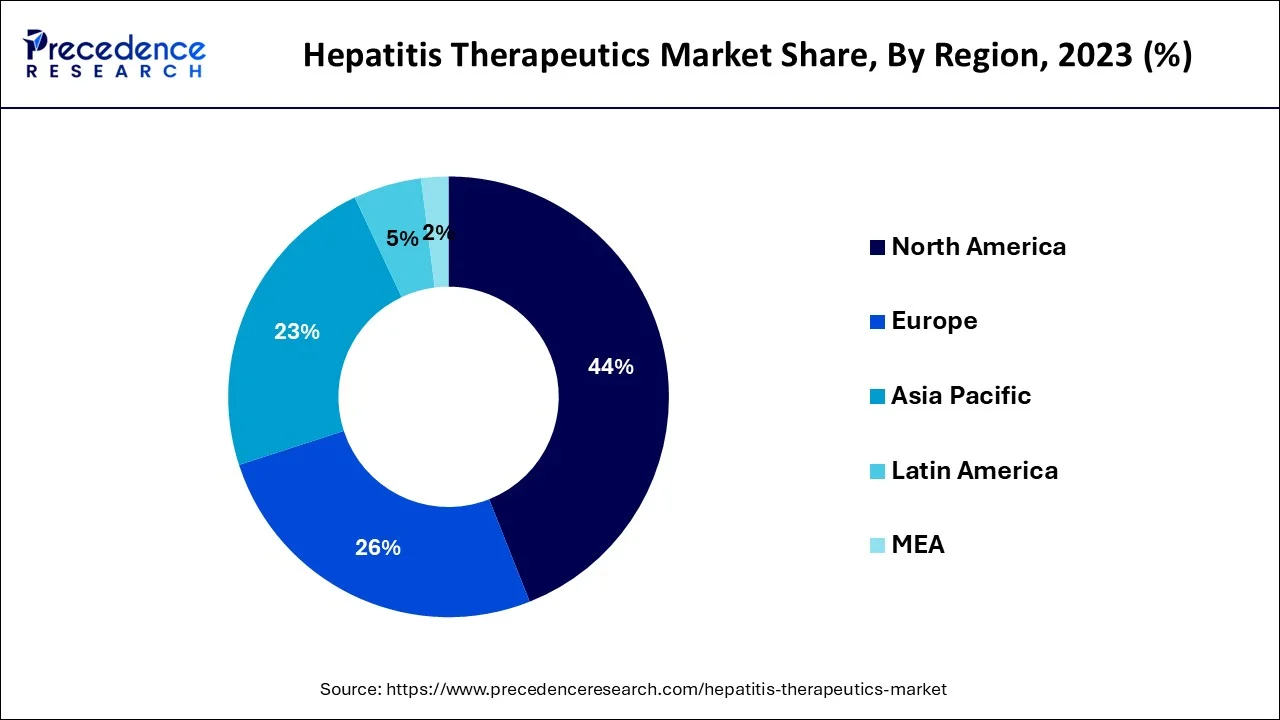What is the Hepatitis Therapeutics Market Size?
The global hepatitis therapeutics market size is calculated at USD 17.80 billion in 2025 and is predicted to increase from USD 28.61 billion in 2026 to approximately USD 27.80 billion by 2035, expanding at a CAGR of 4.56% from 2026 to 2035.

Hepatitis Therapeutics Market Key Takeaways
- On the basis of geography, The North American market generated more than 44% of total revenue in 2025.
- On the basis of disease type, the second-largest revenue share owing to the high prevalence of hepatitis B.
- On the basis of distribution channels, the drug store, and retail pharmacies segment is expected to see the highest growth from 2026 to 2035.
What are Hepatitis Therapeutics?
An inflammation of the liver is known as hepatitis. The use of narcotics, alcohol, or specific medical conditions can all cause hepatitis. However, viral hepatitis, of which the most prevalent kinds are hepatitis A, B, and C. Hepatitis B is quite prevalent and can cause severe liver cirrhosis, which can be deadly.
How is AI contributing to the Hepatitis Therapeutics Industry?
AI has changed the whole scenario of hepatitis therapeutics by enabling quick diagnosis, effective treatment, and drug discovery for new medications in a shorter time. Its application is thus, from detecting liver damage through medical imaging analysis and predicting the results of individual treatments to the discovery of new antiviral substances through predictive modeling.
Besides, it also supports clinicians by means of automating liver segmentation, transplant planning, and risk assessment, thus reinforcing precision care and maintenance of chronic diseases in the long run.
Hepatitis Therapeutics Growth Factor
Hepatitis is liver inflammation brought on by a viral infection. Viruses such as virus A, virus B, virus C, virus D, virus E, and virus G are among those that cause hepatitis. The infection causes the liver's tissues to become inflamed, which can result in cancer and liver cirrhosis. The infection damages other bodily systems and decreases liver function. Acute and chronic hepatitis are both possible. Hepatitis B & C are the most dangerous and difficult to cure of all kinds. Hepatitis infection incidences are rising as a result of rising alcohol and drug use combined with large populations living in unclean settings.
On the basis of these reasons, the market for hepatitis treatments is predicted to see exponential expansion. The elimination of hepatitis is becoming increasingly important, and many nations and international organizations' rising understanding of this reality will be a major driver of the market's expansion for hepatitis therapies.
For instance, the WHO published a recommendation in 2016 calling for the eradication of viral hepatitis by 2030. Additionally, many campaigns like World Hepatitis Day aid governments in raising awareness about hepatitis. These programs act as market growth accelerators for hepatitis treatments.
Companies are funding R&D initiatives to create cutting-edge technology. The hepatitis therapeutics market is predicted to develop as a result of this aspect. As part of their expansion plans, players are also engaging in mergers, acquisitions, joint ventures, and partnerships. All of these factors ultimately aid in accelerating the market for hepatitis treatment growth rate. To ensure that their citizens receive top-notch care, many nations are concentrating on improving their healthcare regulations. The hepatitis therapeutics market is anticipated to grow as a result of favorable reimbursement policies adopted by numerous government bodies around the world.
- During the projected period, improving healthcare facilities and growing patient awareness of sophisticated therapies are expected to drive market growth.
- Over the course of the forecast period, the market is anticipated to be driven by the introduction and development of generic versions of hepatitis C virus (HCV) medications.
- Key opportunities for the market's expansion are anticipated to be provided by emerging markets and significant investment in R&D activities.
Market Outlook
- Industry Growth Overview: The industry is still growing thanks to constant therapeutic innovation, better diagnostic capabilities, and the wide development of targeted antiviral solutions in the international markets.
- Global Expansion: Regional expansion is performed through collaboration in initiatives, with the introduction of new therapies, and through greater acceptance of advanced care models in both the developed and the developing world.
- Major Investors: Gilead, Bristol-Myers Squibb, Biocon, and other investors are the major players in funding innovative antiviral research and revolutionary diagnostic technology development.
Market Scope
| Report Coverage | Details |
| Market Size in 2025 | USD 17.80Billion |
| Market Size in 2026 | USD 18.61 Billion |
| Market Size by 2035 | USD 27.80Billion |
| Growth Rate from 2026 to 2035 | CAGR of 4.56% |
| Base Year | 2023 |
| Forecast Period | 2026 to 2035 |
| Segments Covered | By Disease Type and By Distribution Channel |
| Regions Covered | North America, Europe, Asia-Pacific, Latin America and Middle East & Africa |
Market Dynamics
Key Market Drivers
Advancement in research and development activities
The rise in the prevalence of various hepatitis increased R&D efforts, clinical trials of hepatitis drugs, an increase in the number of product launches and item endorsements, and the development of new hepatitis drugs for the treatment of various hepatitis types are the main factors driving the growth of the hepatitis therapeutics market.
The market is growing rapidly due to increased, coordinated research activities for the pipeline development of potent drugs. Additionally, collaboration and association in important organizations increase persistent awareness of hepatitis therapeutics and the presentation of low-approximated hepatitis therapeutics are other factors that promote the market's growth.
Rising new medicine releases and hepatitis drug approvals from regulators
The worldwide market for hepatitis pharmaceuticals is anticipated to rise over the forecast period due to an increase in regulatory authority approvals for hepatitis drugs. A very effective and targeted NS5A inhibitor of the hepatitis C virus NS5A replication complex, Elbasvir was licensed by the U.S. FDA in 2016 for the treatment of hepatitis C. During the projected period, the introduction of innovative hepatitis medication therapies is anticipated to fuel market expansion. For instance, in India, Natco Pharma in 2018 introduced Hepcinat Plus, a fixed dosage combination of Sofosbuvir-Daclatasvir tablets for the treatment of Hepatitis C.
Key Market Challenges
Hepatitis medications are quite expensive
Due to the high capital required for producing hepatitis pharmaceuticals, it is estimated that the market for hepatitis medications would expand slowly throughout the anticipated period. The cost of hepatitis medicines is costly since they are produced using pricy raw materials, such as active pharmaceutical ingredients (APIs) and pharmacological intermediates. The complex process of generating, separating, and utilizing raw materials for the production of pharmaceutical and biopharmaceutical treatments increases the cost of medicines as a whole since a skilled workforce is required.
Key Market Opportunities
Increasing hepatitis C disease prevalence
The hepatitis C virus is what causes the liver condition known as hepatitis C. The severity of hepatitis C can range from moderate to fatal. Acute hepatitis C develops within six months after being exposed to the hepatitis C virus, and if ignored, chronic hepatitis C can turn into lifelong hepatitis C. The World Health Organization (WHO) reported in July 2021 that an estimated 58 million individuals had chronic hepatitis C virus and that 1.5 million new infections take place every year.
The hepatitis C virus is a blood-borne disease, and exposure to tiny amounts of blood is the most typical way to become infected, claims the same source. This frequently occurs after receiving dangerous injections and medical treatment.
In the market for hepatitis therapies, the hepatitis C category holds a sizable market share. Due to the increasing incidence of hepatitis C in both emerging and developed nations as well as the expanding availability of efficient medications on the market, it is anticipated to exhibit a similar pattern over the course of the projected period. Additionally, the launch of various treatments by significant companies is anticipated to accelerate the growth of the hepatitis therapeutics market.
Segment Insights
Disease Type Insights
The hepatitis B virus (HBV) can cause both acute and chronic liver disease by infecting the liver. According to the WHO, there are an estimated 240 million individuals living with chronic hepatitis B, and more than 686,000 of them pass away each year as a result of its consequences. Blood and other bodily fluids from an infected individual can spread the virus. Due to the high prevalence of hepatitis B, the market was valued at USD 2.6 billion in 2016 and represented the second-largest revenue share.
HBV is required for the Hepatitis D Virus (HDV) to multiply and spread throughout the body. A ribonucleic acid virus is HDV. There are currently no viable treatments for HDV, which affects over 15 million individuals worldwide. As a result, vaccination against HBV is highly advised to avoid hepatitis B and D. This is one of the main factors influencing the market's current revenue share. Compared to hepatitis A and B, HCV causes a number of major side effects.
The WHO estimates that 130 to 150 million people throughout the world have HCV infection. Additionally, almost 700,000 individuals die from liver cancer and cirrhosis, both of which are common among HCV-infected patients. Over the projection period, the aforementioned reason will continue to fuel demand for HCV medications.
Growth has been significantly influenced by the advent of therapeutic treatments for the treatment of hepatitis that are technologically sophisticated. Hepatitis C was formerly incurable, but after the release of drugs like Sovaldi and Harvoni in 2013 and 2014, respectively, the treatment rate has considerably risen. These treatments allegedly generated sales of approximately USD 19.1 billion in 2015, and the demand for these medications is anticipated to be robust throughout the next years.
Distribution Channel Insights
Due to the growing availability of both branded and generic medications, the pharmacy store and retail pharmacies category is predicted to see the highest growth throughout the projection period. Due to the tempting discount deals offered by online providers, which are anticipated to entice more clients to choose their services, online providers are also anticipated to see the quickest growth rate over the projection period.
Regional Insights
What is the U.S. Hepatitis Therapeutics Market Size?
The U.S. hepatitis therapeutics market size is estimated at USD 5.48 billion in 2025 and is expected to be worth around USD 8.76 billion by 2035, rising at a CAGR of 4.80% from 2026 to 2035.

North America, followed by Europe and Asia Pacific, dominates the market for hepatitis treatments. The North American market accounted for 44% of total revenue in 2025, mostly because of the region's high awareness of advanced treatments and the U.S.'s strong demand for the products. Some of the key elements influencing the high share are the availability of a well-developed healthcare infrastructure, reimbursement, and access to the most cutting-edge medications.
U.S. Hepatitis Therapeutics Market Trends:
The U.S. is offering plenty of opportunities through the fast-paced acceptance of the new hepatitis drugs, robust insurance backing, and the initiation of screening programs. The increasing interest in next-gen therapies, predictive care technologies, and the opening up of more treatment pathways is aiding in the management of the disease, and the patient is getting access to the advanced therapeutics, getting better.

Over the projected period,the Asia Pacific market is anticipated to grow at the quickest pace of 6.4%.The region's growth prospects are anticipated to be favorably reinforced by the high illness burden, expanding access to medications, improvements in healthcare and sanitation, and increased knowledge of hepatitis vaccination. To make it easier for more people to access high-quality healthcare, nations like India, China, Indonesia, and other South Asian economies are continually boosting their healthcare spending and reimbursement coverage.
Additionally, it is projected that the Asia Pacific area would benefit from the rising need for generic medications. Gilead has granted permission to seven Indian producers to export some of the hepatitis medications to several nations. More than half of the people who have HCV infection live in the countries that are included in this agreement.
Asia Pacific: China/India Hepatitis Therapeutics Market Trends:
The different licenses negotiated by the Medicine Patent Pool allow different manufacturers to release generic versions of these HCV medications even though the medications are still patented. This is expected to have an impact on the market over the course of the forecast period, as drug prices will decline, and consumption rates will rise. However, due to the high incidence rates and increase in the import of generic medications to treat various hepatitis disorders, MEA and Latin America are also predicted to have considerable growth.
China and India seem to be very opportunistic, as they are driven by the very widespread unmet needs and demands, the increasing treatment accessibility, and the expanding public health programs. The local manufacturing, the increased uptake of screening, and the bigger vaccinations are all working together to improve the reach of therapy and enhance the possibility of long-term disease management being enhanced.
Different manufacturers are growing their operations in MEA and Latin America areas to meet the significant unmet demands for improved treatment as the patient population in the U.S. and other developed countries is decreasing as a consequence of the benefits of taking HCV medications.
What are the driving factors of the Hepatitis Therapeutics Market in Europe?
Europe is expected to grow significantly due to the well-established healthcare systems and widespread implementation of the hepatitis treatment programs. The emphasis on monitoring, prevention, and standardized care paves the way for long-term disease control and even promotes the use of advanced therapies in various healthcare environments.
Germany Hepatitis Therapeutics Market Trends:
Germany enjoys the perks of having all its citizens' health covered, modern medical facilities, and ongoing screening and vaccination campaigns. The main focus is on the quick adoption of the new antiviral options, the growth of clinical research, and the national government's commitment to improving hepatitis diagnosis and treatment outcomes in the long run.
Value Chain Analysis
- R&D: The act of discovering and designing new compounds for hepatitis treatment, followed by preclinical testing, is the first step.Key Players: Gilead Sciences, AbbVie
- Clinical Trials and Regulatory Approvals: Safety and efficacy are established through human testing in phases before regulatory submission and approval.
Key Players: IQVIA, Parexel, PPD - Formulation and Final Dosage Preparation: The drug substances that are approved are made into stable, scalable final products with the best dosage forms for the patients.
Key Players: Pfizer CentreOne, Catalent - Packaging and Serialization: Product packaging includes critical information and serialized identifiers that ensure traceability and are used in combating counterfeiting cases in the supply chains.
Key Players: West Pharmaceutical Services, Schott - Distribution to Hospitals, Pharmacies: The delivery of finished products through the supply chains ensures that healthcare providers and ultimately patients receive them timely and efficient manner.
Key Players: AmerisourceBergen, McKesson
Hepatitis Therapeutics Market Companies
- Gilead Lifesciences: Gilead nowadays doesn't just offer drug treatments for the Hepatitis C virus but also provides medicine that can cure the virus completely and help patients manage their Hepatitis B and D infections over the long term.
- Biocon: Biocon is involved in the production of generics for the Hepatitis C virus through strategic licensing, which, apart from making the treatment accessible to more patients, also contributes to the overall market in the healthcare sector of developing countries.
- Bristol-Myers Squibb: Chronic hepatitis B and C treatment are two of the main areas of BMS's hepatitis therapies. The firm is also active in licensing generic drugs for the treatment of hepatitis C as a measure to make it available to more patients.
Other Major Key players
- AbbVie
- Merck & Co., Inc.,
- Johnson & Johnson
- Roche
- Novartis
- Sanofi
- Cipla
Recent Developments
- In December 2025, Mirum Pharmaceuticals entered a definitive agreement to acquire Bluejay Therapeutics, enhancing its portfolio with brelovitug, a monoclonal antibody targeting chronic hepatitis delta virus. This acquisition strengthens Mirum's position in rare diseases and supports its expertise in liver disorders, with potential registrational readouts forthcoming.(Source: https://www.businesswire.com )
- In July 2025, TherVacB, a new therapeutic hepatitis B vaccine from Helmholtz Munich and DZIF, began its phase Ib/IIa clinical trial after a successful phase Ia, demonstrating safety and immune response. The first patient was enrolled in June 2025.(Source: https://www.dzif.de )
- The US Food and Drug Administration (FDA) granted Epclusa (sofosbuvir/velpatasvir) clearance in June 2021 for the treatment of chronic hepatitis C virus (HCV) in children under 3 years of age, regardless of the HCV genotype or severity of the liver disease.
- The Phase II combo study of the experimental GalXC RNAi candidate, RG6346, for the management of chronic hepatitis B virus (HBV) infection was started in March 2021 by Dicerna Pharmaceuticals and Roche.
Segments Covered in the Report
By Disease Type
- Hepatitis A
- Hepatitis B
- Hepatitis C
- Others
By Distribution Channel
- Hospital Pharmacies
- Drug Stores and Retail Pharmacies
- Online Providers
ByGeography
- North America
- Europe
- Asia-Pacific
- Latin America
- The Middle East and Africa
 Get a Sample
Get a Sample
 Table Of Content
Table Of Content



